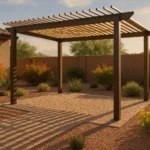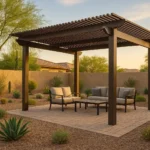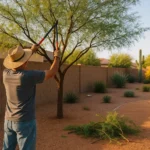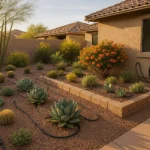Living in Gilbert means adapting to our intense desert sun and seasonal temperature shifts. As a longtime resident and native plant enthusiast, I’ve watched countless homeowners struggle with creating outdoor spaces that remain comfortable throughout our challenging climate cycles. The right shade structure isn’t just a luxury in our Southeast Valley—it’s essential for making your outdoor living space usable year-round. Whether you’re facing our blistering summer heat or trying to extend your patio season into the cooler months, seasonal shade planning can transform how you experience your Gilbert home.
Understanding Gilbert’s Seasonal Shade Needs
Gilbert’s climate demands thoughtful shade planning that evolves with the seasons. Our summers bring relentless sunshine with temperatures regularly exceeding 110°F, when even morning gardening becomes unbearable without adequate protection. During these months, dense, complete shade is non-negotiable for any functional outdoor space. As we transition to fall, those same structures might benefit from allowing more filtered light, especially as our mornings and evenings cool down significantly.
Winter in Gilbert presents a different challenge altogether. While our mild winters are the envy of much of the country, temperatures can drop into the 40s, and we actually want to maximize sun exposure during these cooler months. Many Gilbert homeowners make the mistake of installing permanent shade solutions that work perfectly in July but leave their patios chilly and dark in January. The seasonal shade dance in our region is about finding that sweet spot between protection and exposure as the sun’s angle and intensity shift throughout the year.
Spring brings spectacular bursts of color throughout Gilbert landscapes, with palo verdes erupting in golden blooms and desert wildflowers painting the surroundings in vibrant purples and oranges. This is when adjustable shade options become particularly valuable—allowing you to enjoy these seasonal displays while still having protection during increasingly warm afternoons. Understanding these seasonal patterns is the first step toward creating an outdoor space that works with Gilbert’s unique climate rather than against it.
Summer Shade Solutions: Beating the Extreme Heat
When summer arrives in Gilbert, effective shade becomes about survival, not just comfort. From May through September, prioritize dense, complete coverage for any areas you hope to use during daylight hours. Solid patio covers constructed from insulated materials offer the most reliable protection against our intense summer sun. These permanent structures typically feature aluminum or steel frames with insulated panels that not only block direct sunlight but also reduce radiant heat. For maximum cooling effect, opt for light-colored or reflective roofing materials that won’t absorb and radiate heat downward.
Shade sails have become increasingly popular throughout Gilbert neighborhoods, and for good reason. These tensioned fabric membranes can be installed in overlapping layers to create near-complete shade while maintaining an airy, modern aesthetic. The key for summer effectiveness is selecting high-density polyethylene fabrics with UV block ratings of 95% or higher. I’ve seen dramatic temperature differences of 15-20 degrees under quality shade sails compared to unprotected areas. Position them at angles that account for the summer sun’s path, which is higher and more directly overhead during these months.
Don’t overlook the cooling potential of vegetation during our hottest season. Deciduous trees like desert willow, palo verde, and mesquite provide natural shade that actually cools through transpiration—essentially nature’s evaporative cooling system. The dappled light beneath these native trees creates fascinating patterns of summer color as sunlight filters through their canopies, casting shifting shadows that dance with the breeze while significantly reducing ground temperature. Combining these living shade elements with structural solutions gives you the most comprehensive summer protection while enhancing your property’s beauty and ecological value.
Fall Transition: Adjustable Shade Strategies
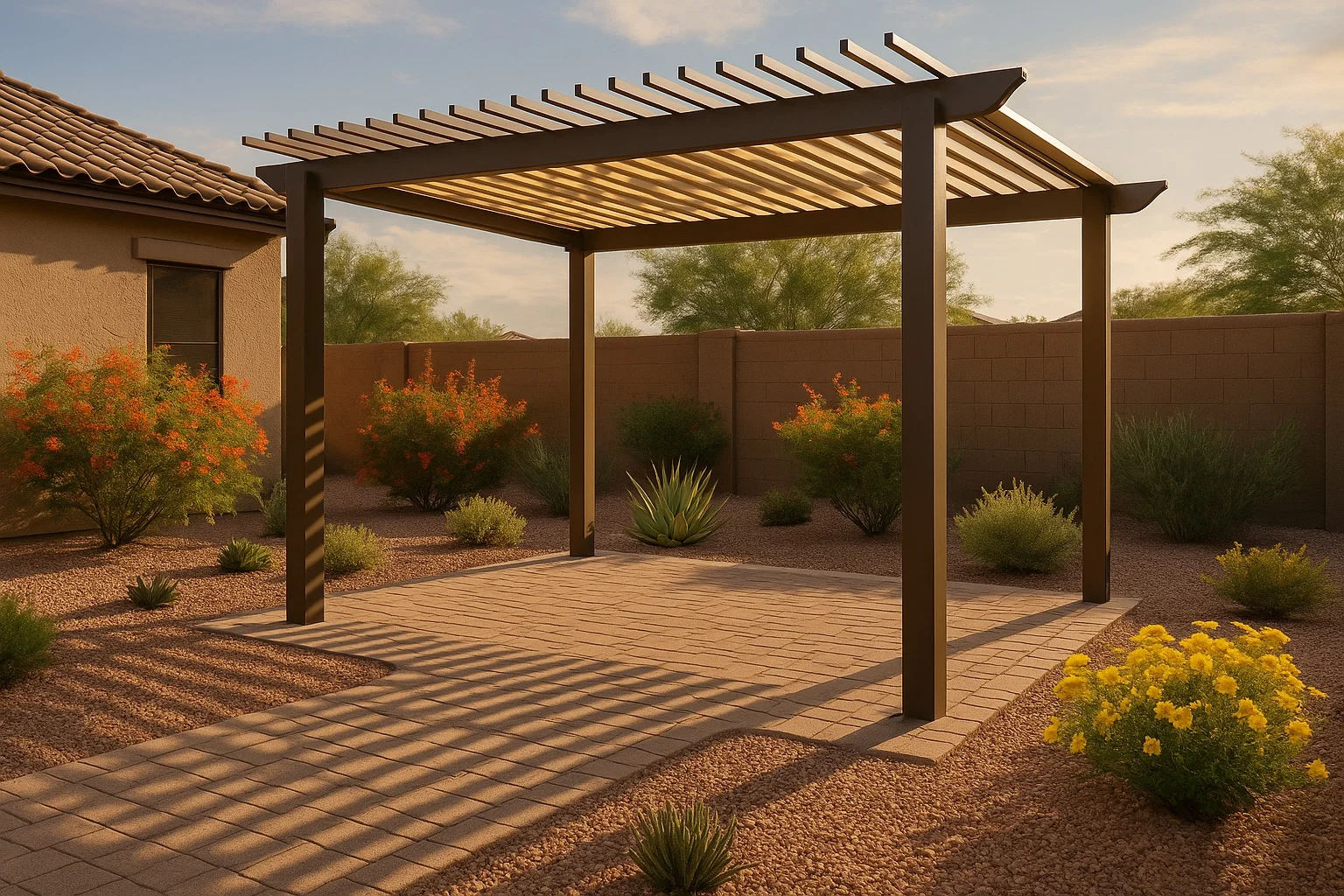
As Gilbert transitions into fall, our outdoor living potential expands dramatically. September and October temperatures become increasingly pleasant, especially in mornings and evenings, making this the perfect season to implement adjustable shade solutions. Retractable awnings offer excellent versatility, allowing you to extend full coverage during the still-warm afternoons while retracting in the evenings when temperatures drop. Look for motorized options with wind sensors that automatically retract during our occasional fall storms—a feature that has saved many Gilbert homeowners from costly damage.
Louvered pergola systems represent the pinnacle of seasonal adaptability for Gilbert yards. These structures feature adjustable slats that can be positioned to block direct sun while allowing ambient light and cooling breezes to filter through. As fall progresses and the sun’s angle lowers, you can adjust the louvers to track the changing light patterns. The seasonal color play beneath these structures is particularly striking in autumn, as the filtered light creates dramatic shadows that shift throughout the day, highlighting the warm earth tones that characterize our desert landscape this time of year.
Fall is also an ideal time to incorporate temporary shade elements that can be easily removed or repositioned. Outdoor curtains in weather-resistant fabrics add both shade flexibility and visual softness to structural elements like pergolas or gazebos. These can be drawn closed during the still-warm afternoons and opened as evening approaches. The gentle movement of these fabrics in our fall breezes creates a soothing atmosphere while introducing seasonal color through fabric choices—consider the rich oranges, deep reds, and golden hues that complement our autumn desert palette. These temporary elements allow you to fine-tune your shade experience as Gilbert’s weather becomes increasingly variable.
Winter Considerations: Balancing Sun and Shelter
Winter transforms shade priorities in Gilbert completely. From December through February, most homeowners want to maximize sun exposure while maintaining protection from occasional rain and cooler winds. This is where retractable or seasonal shade structures truly prove their worth. Retractable canopies should be opened on sunny winter days to allow the warming rays to heat your patio surfaces, which will retain and radiate that heat as temperatures drop in late afternoon. The winter sun sits lower in the southern sky, creating longer shadows but also providing welcome warmth if your space is properly oriented.
For fixed structures like pergolas, winter adaptations might include removing seasonal shade cloths or rolling up bamboo screens that provided denser summer coverage. The more open framework allows beneficial winter sunlight to penetrate while still providing some structure for outdoor living. The changing angle of winter sunlight creates dramatic patterns across Gilbert landscapes, with the lower sun casting longer, more defined shadows that highlight architectural features and plant structures. These seasonal light changes transform familiar spaces, revealing new beauty in the clean, clear winter light characteristic of our desert region.
Winter in Gilbert also presents the opportunity to enjoy outdoor fire features that complement your shade structures. Fire pits, outdoor fireplaces, or even portable heaters can extend evening use of partially covered spaces well into the cooler months. Consider how your shade structure might incorporate or accommodate these warming elements—perhaps a pergola with an adjacent fire pit, or a ramada with built-in infrared heaters. The contrast between open areas that capture daytime sun and covered spaces that retain evening warmth creates the perfect microclimate for winter outdoor living, allowing Gilbert residents to enjoy our mild winters to their fullest.
Spring Renewal: Preparing for the Heat Cycle
Spring in Gilbert brings our most glorious weather but also serves as the critical preparation period for the punishing heat ahead. March through May is the ideal time to inspect, repair, and upgrade your shade structures before summer arrives. Examine fabric elements for UV damage, check tension systems on shade sails, and ensure all mechanical components of retractable systems are functioning properly. This is also the perfect season to clean shade materials, as dust and pollen accumulation can significantly reduce their reflective properties and heat resistance.
The spring months showcase some of Gilbert’s most spectacular seasonal color displays, with wildflowers, cacti blooms, and flowering trees creating a riot of purples, yellows, and reds throughout our landscapes. Adjustable shade systems allow you to appreciate these ephemeral displays while still having protection during increasingly warm afternoons. Consider how your shade structures frame these views—perhaps positioning seating to capture the sight of a blooming palo verde or saguaro while remaining comfortably protected from the strengthening spring sun.
This transition season is also ideal for installing new shade elements before summer heat makes outdoor work unbearable. If you’re planning additions or upgrades, spring offers the perfect weather window for construction. Consider how new elements will integrate with existing structures and vegetation, particularly as trees leaf out to their full summer canopies. The interplay between structural shade and living shade creates rich seasonal color variations as light filters through new spring growth, casting green-tinted shadows that shift and dance with the breeze. These dynamic light patterns add visual interest and a sense of connection to Gilbert’s natural seasonal rhythms.
Material Considerations for Gilbert’s Climate
Selecting appropriate materials for shade structures in Gilbert requires understanding our unique environmental challenges. Our combination of intense UV exposure, monsoon winds, and extreme temperature fluctuations quickly destroys inferior products. For fabric elements, commercial-grade shade cloths with UV stabilizers and at least a 10-year warranty should be your minimum standard. Look for materials specifically rated for desert conditions—many products marketed nationally simply cannot withstand our intense summer sun. These high-performance fabrics maintain their color integrity through seasonal exposure, preventing the fading that quickly makes less durable materials look shabby and worn.
For structural elements, powder-coated aluminum offers an excellent balance of durability and weight. Unlike steel, it won’t rust in our occasional rain, and unlike wood, it won’t warp or crack in our extreme dry heat. If you prefer the warmth of wood, consider hardwoods like ipe or redwood that contain natural oils that help them withstand our climate swings. The visual character of these materials changes subtly with the seasons—aluminum structures cast sharper, more defined shadows in winter’s clear light, while wooden elements develop richer patinas that glow warmly in the golden light of spring and fall afternoons.
Don’t overlook the importance of quality hardware and connection points. Our seasonal temperature fluctuations cause significant expansion and contraction that can loosen connections over time. Marine-grade stainless steel fasteners offer the best long-term performance. For shade sails and other tensioned systems, commercial-grade turnbuckles and attachment hardware will prevent the sagging and failure that plague many DIY installations. The seasonal maintenance of these components—tightening during cooler months when materials contract and possibly loosening slightly during peak heat—ensures your shade structures remain functional and attractive throughout Gilbert’s challenging climate cycles.
Integrating Shade with Gilbert’s Desert Landscape
The most successful shade structures in Gilbert complement rather than compete with our unique desert environment. Consider how your shade elements interact with the seasonal changes in our natural landscape. During spring, when brittlebush erupts in brilliant yellow blooms and penstemon adds splashes of purple to the desert palette, lighter, more open shade structures allow these colors to become part of your outdoor experience. The dappled light through pergolas or shade sails enhances these seasonal displays, creating dynamic patterns that change throughout the day.
As summer approaches and our landscape shifts to the more muted greens and grays of heat adaptation, denser shade structures provide necessary relief while framing views of the surrounding mountains and sky. The contrast between protected, comfortable outdoor rooms and the harsh summer landscape beyond creates a powerful sense of refuge. Consider how your shade structures frame these seasonal views—perhaps positioning a pergola to capture the distant mountain silhouettes that take on rich purple hues during our spectacular summer sunsets.
Native plantings can beautifully complement and enhance seasonal shade strategies. Consider how deciduous desert trees like palo verde, mesquite, or desert willow might work in concert with structural elements—providing additional summer shade when fully leafed out, then allowing more winter sun as they drop their leaves. The seasonal color transitions of these native species—from spring’s vibrant blooms to summer’s deep greens to fall’s subtle gold and amber tones—create an ever-changing backdrop for your outdoor living spaces. By embracing these natural cycles rather than fighting them, your shade solutions become an integrated part of Gilbert’s distinctive desert aesthetic rather than an artificial imposition.
Budget-Friendly Seasonal Shade Options
Creating effective seasonal shade doesn’t have to break the bank. For Gilbert homeowners on a budget, strategic placement of portable shade elements can provide significant comfort improvements. Freestanding umbrellas with heavy bases offer immediate relief and can be repositioned throughout the day to track the sun’s movement. Look for models with UV-resistant fabrics and wind vents to withstand our conditions. While not as durable as permanent solutions, quality market umbrellas can provide several seasons of use if properly maintained and stored during extreme weather.
DIY shade sails represent another accessible entry point for many Gilbert residents. Pre-made sails in standard sizes have become increasingly affordable, and with proper installation techniques, they can provide excellent seasonal protection. The key is proper tensioning and secure attachment points—inadequate installation is the primary reason these budget-friendly options fail prematurely. The visual impact of these colorful, floating forms can be quite dramatic, especially when they pick up seasonal color themes from surrounding landscape elements. A sail in deep purple echoes spring’s desert verbena blooms, while sandy tans blend harmoniously with our summer landscape.
For temporary seasonal shade, consider roll-up bamboo or reed screens that can be attached to existing structures like patios or pergolas. These natural materials provide filtered light rather than complete blockage—perfect for transition seasons when you want protection without total shade. They create beautiful patterns of dappled light that shift throughout the day, highlighting seasonal color changes in your landscape. Their natural materials develop a weathered patina over time that actually enhances their aesthetic appeal, blending beautifully with Gilbert’s desert surroundings. When winter arrives, these can be easily rolled up and stored, allowing maximum sun exposure during cooler months.
Long-Term Planning for Changing Needs
The most successful shade strategies in Gilbert evolve over time, adapting to both seasonal changes and the maturing of your landscape. When planning new installations, consider how young trees might eventually interact with structural elements. That full southern exposure that requires complete shade coverage today might be naturally protected in five years as your desert willow or palo verde reaches maturity. Modular systems that can be reconfigured or expanded offer the most flexibility as your needs change across seasons and years.
Technology continues to advance in the shade structure market, with new materials and smart systems becoming increasingly accessible. Automated systems that adjust based on sun position, temperature, or wind conditions represent the cutting edge of seasonal adaptation. While these carry higher initial costs, they provide unparalleled convenience and effectiveness throughout Gilbert’s challenging climate cycles. The integration of these systems with home automation platforms allows for truly responsive environments that adjust to both seasonal patterns and day-to-day weather variations.
Perhaps most importantly, successful seasonal shade planning requires observation and patience. Spend time in your outdoor spaces throughout the year, noting how sun patterns shift, where heat accumulates, and when different areas become uncomfortable. The seasonal color changes in light quality—from winter’s clear, blue-tinted light to summer’s golden haze—dramatically affect how we experience outdoor spaces. By observing these patterns over multiple seasons, you’ll develop an intuitive understanding of your property’s microclimate that guides more effective shade solutions. This observational approach connects you more deeply to Gilbert’s natural rhythms while creating outdoor spaces that truly enhance your desert living experience throughout the year.

